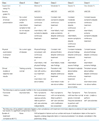A Review of the AMA Guides to the Evaluation of Permanent Impairment
Article information
Abstract
The American Medical Association's Guides to the Evaluation of Permanent Impairment (Guides) has provided an useful guideline in interpreting information on permanent impairment based on the in-depth knowledge and experience in impairment ratings accumulated for a long period of time. Since its first publication by American Medical Association (1958), as 'A Guide to the Evaluation of Permanent Impairment of the Extremities and Back', 12 additional 'guides' has been published by the JAMA over the next 12 years. All the guides were consolidated to become the first official edition of the 'Guides' in 1971. The 'Guides' has been updated periodically to reflect current scientific clinical knowledge and judgment methods. It has become the best system available to evaluate permanent impairments across many disciplines. The latest sixth edition created a "paradigm shift" in the area of the impairment assessment by introducing a contemporary model of disablement. The standardized methods elaborated in the sixth edition clearly enhances the relevancy of impairment ratings, improves internal consistency of the methods and renders the application of the rating process easier. It adopts the terminology and conceptual framework from the International Classification of Functioning, Disability and Health in order to generate five impairment classes. A diagnosis-based grid has been developed for each organ system. Functional history, physical findings and objective clinical test results are integrated to determine the grade within the impairment class. The 'Guides' is the most widely used source for assessing and rating permanent impairments in the United States and can be considered as the best available method for the assessment of permanent impairment.
